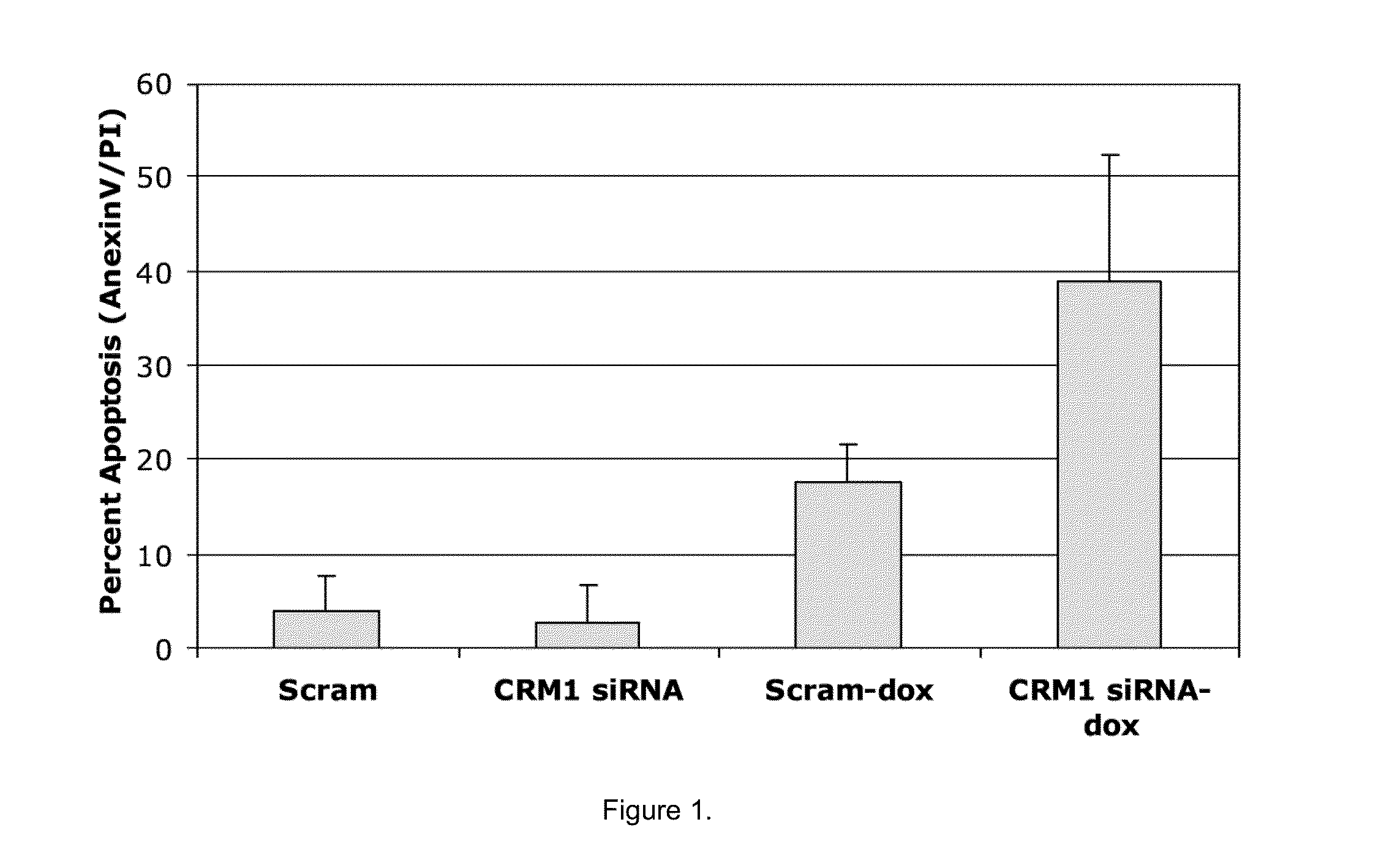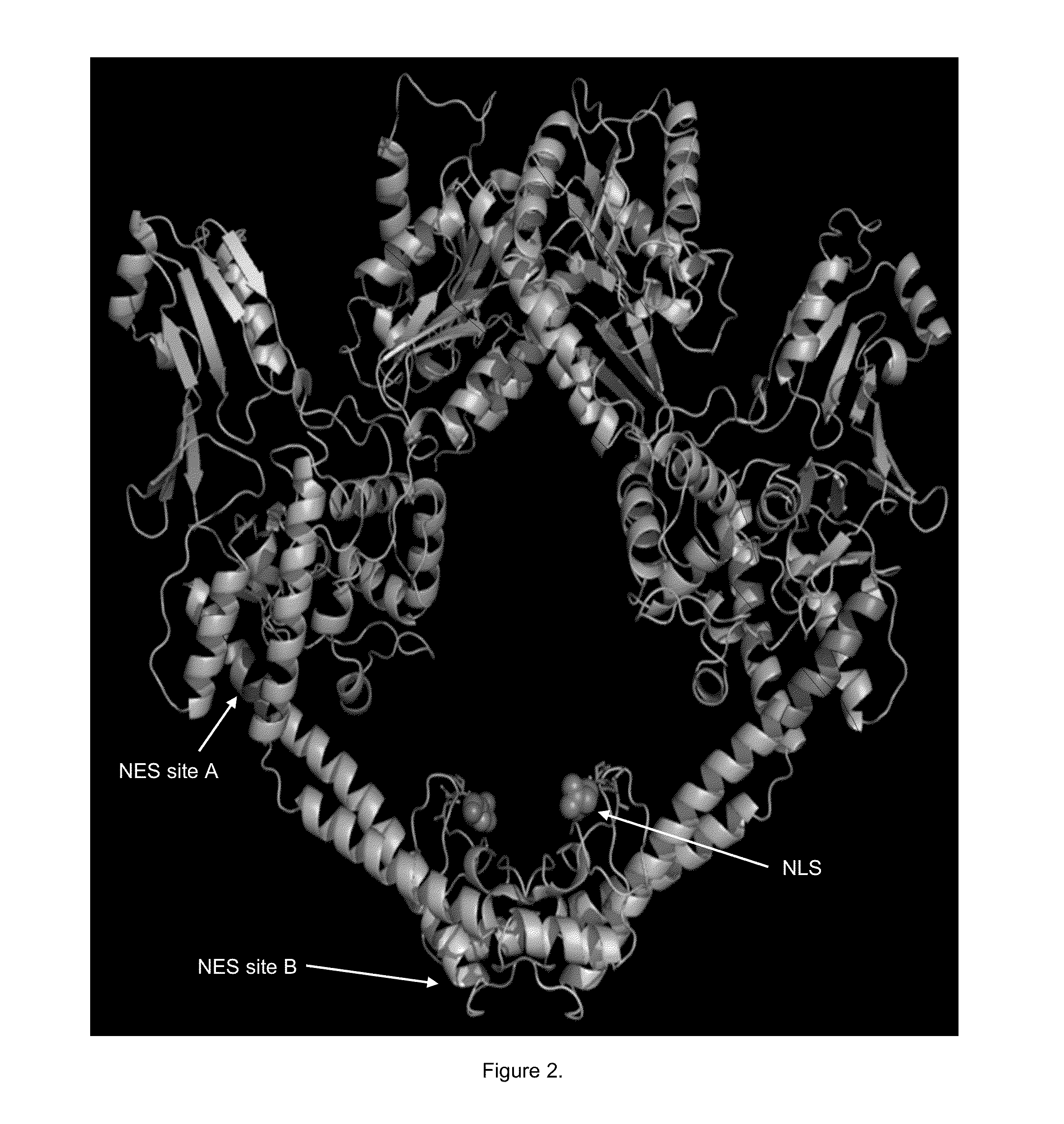Novel drug targets to overcome de novo drug-resistance in multiple myeloma
a multiple myeloma and drug resistance technology, applied in the field of cancer treatment, can solve the problems of ineffective chemotherapeutic targets and non-specific blockage of export of nuclear proteins, and achieve the effect of preventing nuclear export and preventing binding of topo ii
- Summary
- Abstract
- Description
- Claims
- Application Information
AI Technical Summary
Benefits of technology
Problems solved by technology
Method used
Image
Examples
example 1
[0053]To date, there are no known agents that target the NES of a specific protein that are being developed to treat cancer. Because drug resistance to topo II inhibitors occurs when topo IIα is trafficked from the nucleus to the cytoplasm where it is no longer in contact with the DNA and unable to induce cell death (Valkov, et al., Cell density-dependent VP-16 sensitivity of leukaemic cells is accompanied by the translocation of topoisomerase IIalpha from the nucleus to the cytoplasm. Br J Haematol 2000; 108: 331-45, Engel, et al., The cytoplasmic trafficking of DNA topoisomerase IIalpha correlates with etoposide resistance in human myeloma cells. Exp Cell Res 2004; 295: 421-31), a specific NES in topo IIα was targeted as an innovative treatment approach in MM. This provides a very focused and potent combination with topo II inhibitors, which may also overcome de novo drug resistance in MM. The nuclear export signals (NES) for topo IIα have also identified at amino acids 1017-28 (s...
example 2
[0058]Compounds identified in Example 1 as the top scoring potential inhibitors for each of the two NES (20 each) were obtained from NCI and structures of these molecules confirmed using NMR and mass spectroscopy analysis, seen in FIGS. 4(A)-(C) and 5(A)-(D). The potential inhibitors were followed up using in vitro model cell cultures. MM cell lines NCI-H929 (H929) and RPMI-8226 (8226) were obtained from and tested for authenticity by the American Type Culture Collection (Manassas, Va.). All cell lines were grown as described previously (Turner, et al., Human topoisomerase IIalpha nuclear export is mediated by two CRM-1-dependent nuclear export signals. J Cell Sci 2004; 117: 3061-71).
[0059]The molecules with the highest docking scores were assayed for IC50 values. Cultures were tested for cytotoxicity using the CellTiter-Glo assay (CT-Glo cytotoxicity assay; Promega, Madison, Wis.), a luminescence-based homogeneous method for determining the number of viable cells in culture based o...
example 3
[0062]The compounds identified in Example 1 were tested for induction of apoptosis (cleaved caspase 3) as previously described (Turner, et al., Human multiple myeloma cells are sensitized to topoisomerase II inhibitors by CRM1 inhibition. Cancer Res 2009; 69: 6899-905). Inhibition of topo IIα export enhances DNA damaging agents, like intercalation agents such as doxorubicin. Human myeloma cells that maintained nuclear topo IIα were more sensitive to topo IIα-targeted chemotherapy in a synergistic manner, as seen in FIG. 6. As such, cells were treated with 25 μM of each identified NES compound for 20 hours followed by 4 hours with either doxorubicin (2 μM), bortezomib (10 nM), dexamethasone (10 μM), lenalidomide (10 μM), melphalan (10 μM), and topotecan (10 μM).
[0063]Data from caspase 3 apoptosis assays showed that the four lead compounds that dock to NES site A significantly (P<0.05) increased sensitivity of high-density MM cells to doxorubicin, as seen in FIG. 7. NES site A inhibit...
PUM
| Property | Measurement | Unit |
|---|---|---|
| Resistance | aaaaa | aaaaa |
| resistance | aaaaa | aaaaa |
| drug resistance | aaaaa | aaaaa |
Abstract
Description
Claims
Application Information
 Login to View More
Login to View More - R&D
- Intellectual Property
- Life Sciences
- Materials
- Tech Scout
- Unparalleled Data Quality
- Higher Quality Content
- 60% Fewer Hallucinations
Browse by: Latest US Patents, China's latest patents, Technical Efficacy Thesaurus, Application Domain, Technology Topic, Popular Technical Reports.
© 2025 PatSnap. All rights reserved.Legal|Privacy policy|Modern Slavery Act Transparency Statement|Sitemap|About US| Contact US: help@patsnap.com



